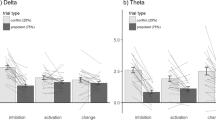Abstract
Autocorrelation of the EEG was used to registrate a potential from the intact human scalp during intended, but not executed movements (dorsalflexion of the right hallux, imaginated in equal time intervals). This “Motor Intention Potential” (MIP) is a possible electrophysiological sign of the otherwise purely introspectively experienced intention of a voluntary movement and the cortex of the frontal lobes is suspected to be its origin. The average maximum amplitude height is 6 μV, and the potential shows a continuous decrease from the frontal to occipital region. The duration of MIP is in the range of seconds. Methodological questions are discussed, and the MIP is differentiated from other event-, movement- and imagination-related potentials. An attempt is made to place the motor intention potential in the context of existing movement theories.
Similar content being viewed by others
References
Allen, G.I., Tsukahara, N.: Physiol. Rev.54, 957 (1974)
Bates, I.A.V.: J. Physiol. (Lond.)113, 240 (1951)
Bechterew, W. v.: Die Funktionen der Nervencentra, Bd. 111. Jena: Fischer 1911
Brix, R.: Arch. Oto-Rhino-Laryng.218, 209 (1978)
Broca, P.: Bull. Soc. anat. Paris36, 398 (1861)
Brodmann, K.: Vergleichende Lokalisationslehre der Großhirnrinde in ihren Prinzipien, dargestellt auf Grund des Zellbaues. Leipzig: Barth 1909
Deecke, L., Scheid, P., Kornhuber, H.H.: Exp. Brain Res.7, 158 (1969)
Deecke, L., Grötzinger, B., Kornhuber, H.H.: Biol. Cybern.23, 99 (1976)
Eccles, J.C.: Facing Reality: Philosophical Adventures by a Brain Scientist. New York: Springer 1970
Economo, C. v.: Cytoarchitektonik der Großhirnrinde des erwachsenen Menschen. Berlin: Springer 1925
Grötzinger, B., Kornhuber, H.H., Kriebel, J.: J. interdiscipl. Cycle Res.5, 287 (1974)
Hess, W.R.: Das Zwischenhirn. Syndrome, Lokalisationen, Funktionen. Basel: Schwabe 1949
Ingvar, D.H., Philipson, L.: Ann. Neurol.2, 230 (1977)
Ingvar, D.H.: Acta neurol. scand.60, 12 (1979)
Ito, M.: Int. J. Neurol.7, 162 (1970)
Jacquy, J., et al.: Clin. Neurophysiol.37, 507 (1974)
Jasper, H.H.: Electroenceph. clin. Neurophysiol.10, 371 (1958)
Jones, E.G., Powell, T.P.S.: Brain93, 793 (1970)
Keidel, W.D.: Z. Biol.111, 54 (1959)
Keidel, W.D., in: Handbook of Sensory Physiology, Vol. 5, Part 3 (Keidel, W.D., Neff, W.D., eds.). Berlin-Heidelberg-New York: Springer 1976
Kleist, K.: Gehirnpathologie, vornehmlich aufgrund der Kriegserfahrungen. Leipzig: Barth 1908
Kornhuber, H.H., Deecke, L.: Pflügers Arch.281, 52 (1964)
Kornhuber, H.H., in: Handbook of Sensory Physiology, Vol. VI, Part 2 (Kornhuber H.H., ed.). Berlin-Heidelberg-New York: Springer 1974
Lewin, K.: Vorsatz, Wille und Bedürfnis. Berlin: Springer 1926
Liepmann, H.: Das Krankheitsbild der Apraxie („motorischen Asymbolie”). Berlin: Karger 1900
Luria, A.R.: Higher Cortical Functions in Man. London: Tavistock 1966
Mac Kay, D.M.: Neuroscience5, 1389 (1980)
Magnus, R.: Körperstellung. Berlin: Springer 1924
Olesen, J.: Brain94, 635 (1971)
Papakostopoulos, D., in: Multidisciplinary Perspectives in Event-related Brain Potential Research. EPA 600/9-77-043. Triangle Park Research Center, North Carolina 1978
Pavlow, I.P.: Werke, I-VI. Berlin: Akademie-Verlag 1954
Roland, P.E., et al.: J. Neurophysiol.43, 118 (1980)
Roland, P.E., et al.: ibid.43, 137 (1980)
Sherrington, C.: The Integrative Action of the Nervous System. New Haven: Yale Univ. Press 1906
Vogt, C., Vogt, O.: Naturwissenschaften14, 1190 (1926)
Wachholder, K.: Ergebn. Physiol.26, 568 (1928)
Walter, W.G., et al.: Nature203, 380 (1964)
Weinberg, H., Walter, W.G., Crow, H.J.: Electroencephal. clin. Neurophysiol.29, 1 (1970)
Author information
Authors and Affiliations
Additional information
Gekürzte und veränderte Fassung der Dissertationsschrift, Medizinische Fakultät der Univers. Erlangen-Nürnberg, 1980. — Neurologische Klinik und Poliklinik der Technischen Universität München
Rights and permissions
About this article
Cite this article
Keidel, M. Das motorische Intentionspotential. Naturwissenschaften 70, 180–185 (1983). https://doi.org/10.1007/BF01047555
Received:
Issue Date:
DOI: https://doi.org/10.1007/BF01047555




